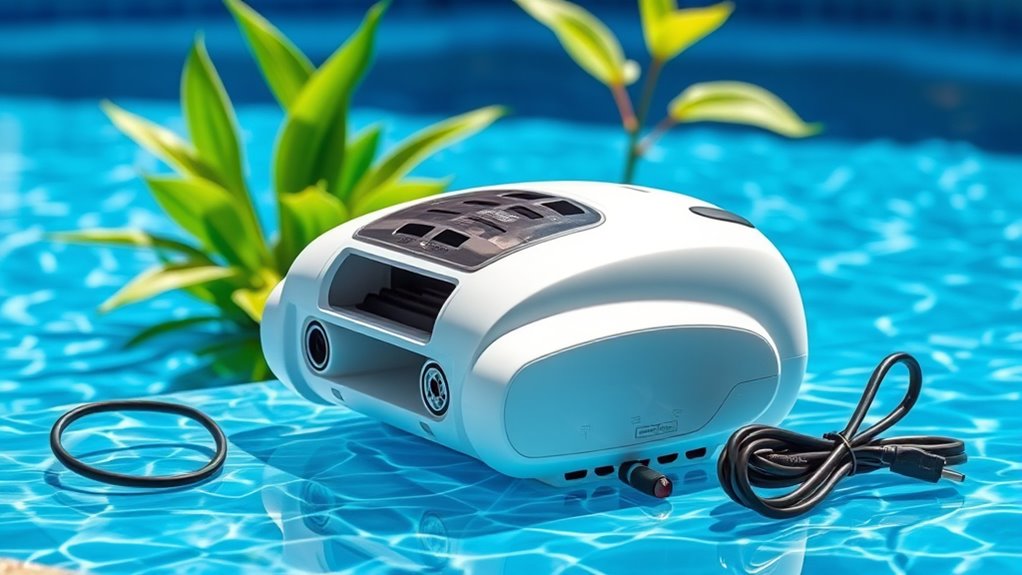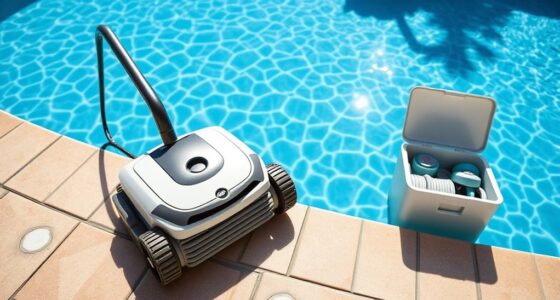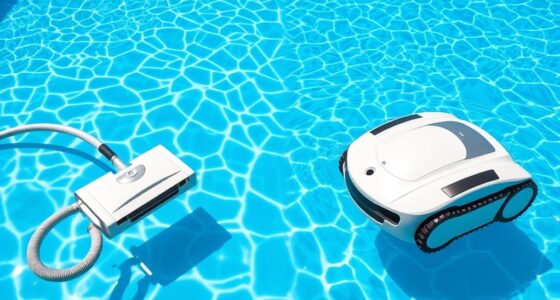To keep your cordless robotic pool cleaner’s battery in top shape, follow proper charging habits, avoid over-discharging, and store it in a cool, dry place. Use the recommended charger, recharge before it drops below 20-30%, and don’t leave it plugged in after full charge. Regularly inspect the battery for signs of wear, and replace it when needed. For detailed tips on maintaining battery health and extending its lifespan, keep exploring this guide.
Key Takeaways
- Use the manufacturer’s recommended charger and avoid overcharging to maintain battery health.
- Store batteries in a cool, dry place with 50-70% charge for long-term preservation.
- Regularly inspect for signs of wear, such as reduced runtime or physical damage, and replace as needed.
- Prevent deep discharges by recharging at 20-30% capacity to extend battery lifespan.
- Dispose of batteries responsibly through recycling facilities to protect the environment.
Understanding Your Battery’s Specifications and Limits
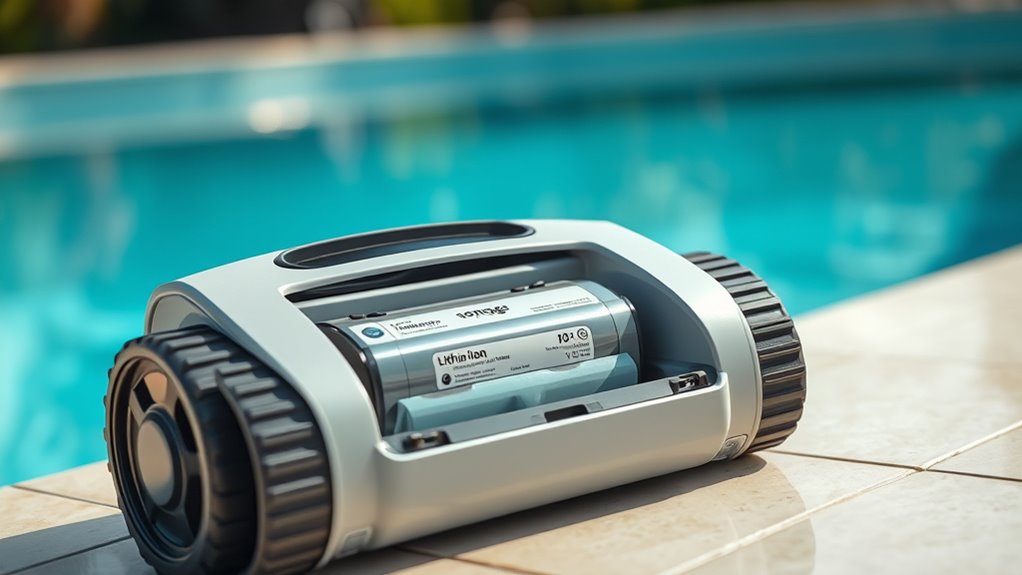
Understanding your battery’s specifications and limits is essential to guarantee your cordless robotic pool cleaner performs at its best and lasts longer. Battery chemistry determines how your battery charges, discharges, and responds to temperature changes. Common chemistries like lithium-ion offer high energy density and longevity, making them ideal for pool cleaners. Voltage capacity indicates how much power the battery can deliver, usually measured in volts. Knowing this helps you avoid overloading the motor or running the battery beyond its safe limits. Always check your battery’s specifications to match your cleaner’s requirements. Proper calibration of your battery and device can further enhance performance and safety. Clear knowledge of your battery’s chemistry and voltage capacity keeps your device running smoothly and safely. Continuous advancements in algorithms also contribute to better battery management systems, enhancing overall safety and performance. Additionally, awareness of battery safety protocols can further help prevent accidents and extend battery life. Staying informed about battery chemistry helps optimize charging practices and prolong your battery’s lifespan. Regularly monitoring your battery’s state of charge can prevent unexpected failures and maintain optimal operation.
Proper Charging Practices for Optimal Battery Health
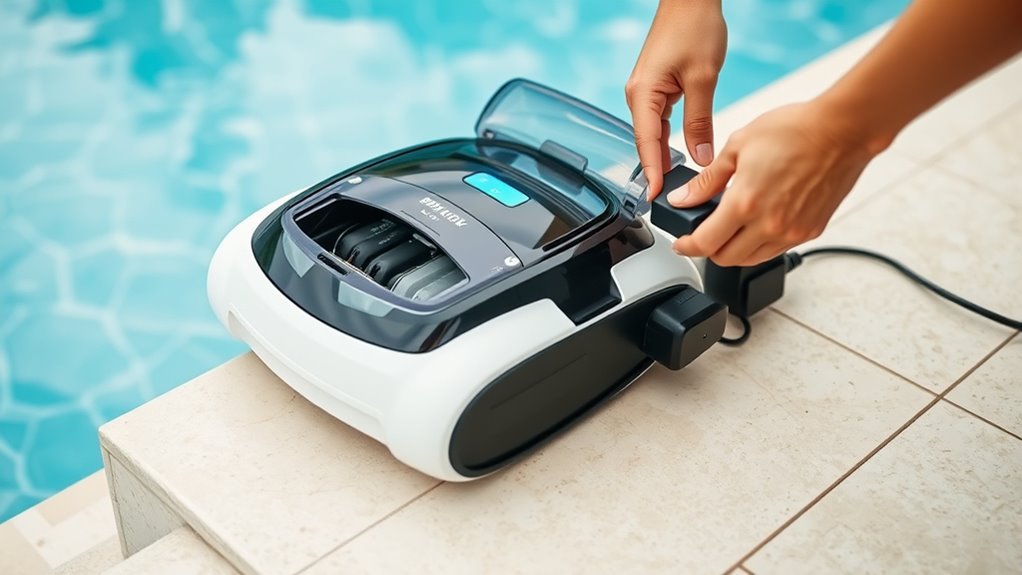
Proper charging practices play an essential role in maintaining your cordless robotic pool cleaner’s battery health and extending its lifespan. To optimize battery lifespan, always follow the manufacturer’s recommended charging times and avoid overcharging. Use the charger provided or a compatible one to ensure charging efficiency. Charge the battery before it completely discharges, ideally when it reaches around 20-30%. Keeping the battery in a cool, dry place during charging also helps preserve its capacity. Avoid leaving the cleaner plugged in for extended periods after it’s fully charged, as this can reduce overall battery health. Regularly monitoring and following these battery care practices can prevent unnecessary wear and tear, ensuring your pool cleaner remains effective and reliable for a longer period. Understanding AI bifurcation concepts can also help you stay informed about the evolving technologies that influence battery management and smart device functionality. Additionally, being aware of battery maintenance tips can further enhance the longevity and performance of your cordless robotic pool cleaner. Incorporating proper storage methods when not in use can further protect the battery from environmental damage and degradation over time. Also, selecting the appropriate charging environment can help maintain optimal battery condition.
Avoiding Over-Discharge and Deep Cycles
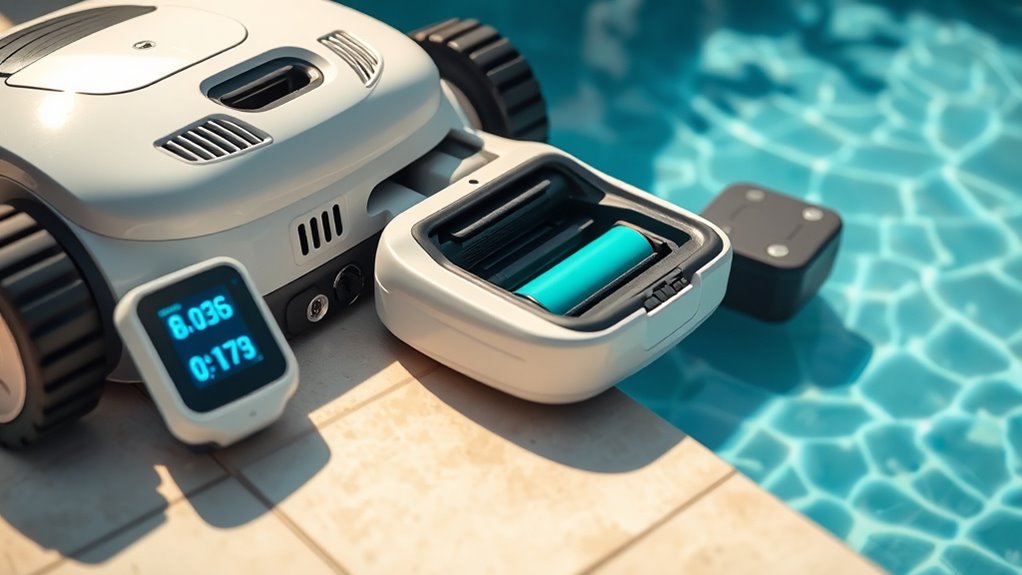
To keep your pool cleaner’s battery healthy, you need to watch its charge level carefully. Avoid letting the battery fully deplete, as deep cycles can shorten its lifespan. By monitoring and preventing complete discharges, you help ensure your cleaner stays reliable and lasts longer. Regularly checking the battery performance can also help you identify potential issues early before they cause significant damage. Using the correct charging procedures also plays a vital role in maintaining battery health. Understanding DE – Patchology.ORG can help you recognize signs of neglect or mishandling that may impact your battery’s care. Additionally, avoiding deep discharge cycles is crucial, as they accelerate battery wear and reduce overall capacity over time.
Monitor Battery Levels
Have you ever wondered why your cordless robotic pool cleaner’s battery life seems to diminish over time? Monitoring battery levels is key to maintaining its battery lifespan. Keep an eye on the charge indicator or use a compatible app if available. Avoid letting the battery fully discharge, as deep cycles can shorten its life. Instead, recharge when it drops to around 20-30%, preventing unnecessary strain on the battery. Frequent, shallow charging cycles are better than waiting for complete depletion. Proper battery management techniques can significantly extend your cleaner’s battery life. Additionally, understanding battery chemistry can help in choosing the right charging practices to optimize performance. Being aware of the charge cycle count can help prevent overuse and early battery failure. By staying aware of the battery’s status, you minimize over-discharge and extend its overall performance. Regularly inspecting the battery health can help identify potential issues early, further preserving its longevity. Practicing these habits and understanding charge cycles can greatly improve your battery’s durability. This simple habit helps preserve your cleaner’s battery health, ensuring it runs efficiently for many swim seasons to come.
Prevent Full Discharges
Avoid letting your cordless robotic pool cleaner’s battery fully discharge, as deep cycles can considerably reduce its battery capacity over time. Deep discharges increase the number of discharge cycles your battery endures, which accelerates wear and shortens its overall lifespan. To prevent this, recharge the battery before it drops below 20% capacity. Regularly monitoring the battery level helps you avoid over-discharge, preserving the battery’s health. Keeping the battery within ideal charge ranges minimizes stress on the cells, ensuring it maintains maximum capacity for longer periods. Proper battery maintenance and avoiding full discharges help extend the number of usable discharge cycles, which in turn prolongs the life of your cleaner’s battery and maintains its performance over time. Additionally, understanding the impact of discharge cycles can help you better manage your battery’s longevity.
Keeping the Battery at the Right Temperature
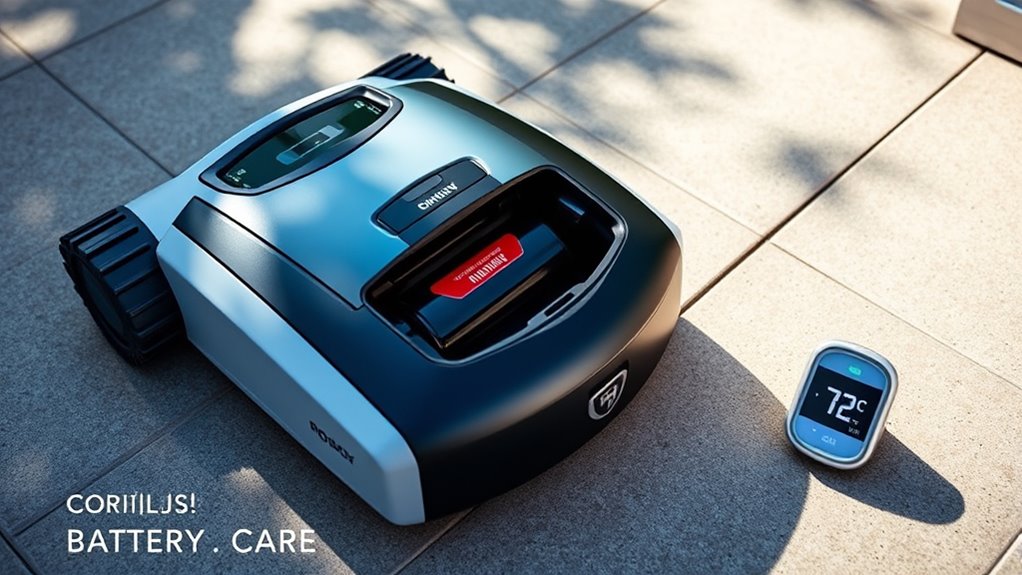
Maintaining the right temperature for your robotic pool cleaner’s battery is essential for ideal performance and longevity. Proper thermal regulation guarantees the battery operates within its optimal temperature range, preventing overheating or freezing that can damage the cells. Keep the device away from direct sunlight or extreme cold, especially during charging and storage. If your pool cleaner has a temperature indicator or warnings, pay attention to them and adjust accordingly. Avoid charging the battery in hot environments, as high battery temperature can reduce capacity and lifespan. Conversely, storing or using the cleaner in cold conditions can impair performance. By controlling the environment and avoiding temperature fluctuations, you help preserve your battery’s health and ensure reliable, efficient operation every time.
Regular Maintenance and Inspection Routines
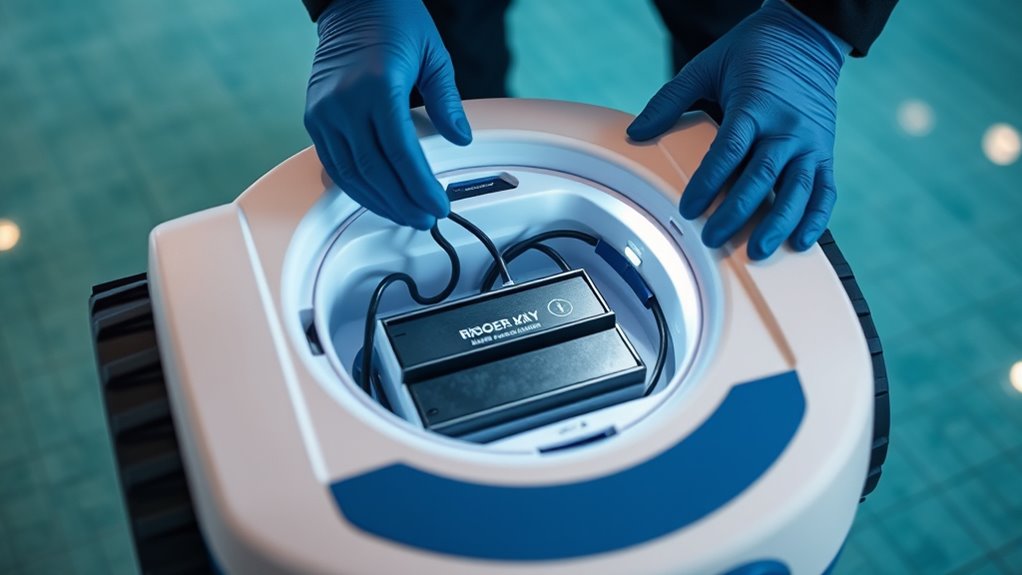
Regular maintenance and inspections are crucial to keep your robotic pool cleaner operating smoothly and to extend its lifespan. Regularly check the battery for any signs of damage or corrosion, and ensure connections are secure. Always follow charging safety guidelines, like avoiding overcharging or using incompatible chargers, to prevent potential hazards. Clean the battery contacts and interior compartments as needed to maintain maximum performance. When the battery reaches the end of its life, dispose of it responsibly by recycling it at designated facilities—never throw batteries in regular trash. Incorporate a routine into your maintenance schedule to spot issues early, ensuring your cleaner operates efficiently and safely. Proper care not only protects you but also promotes environmentally friendly battery recycling practices.
Storing the Cleaner and Battery When Not in Use
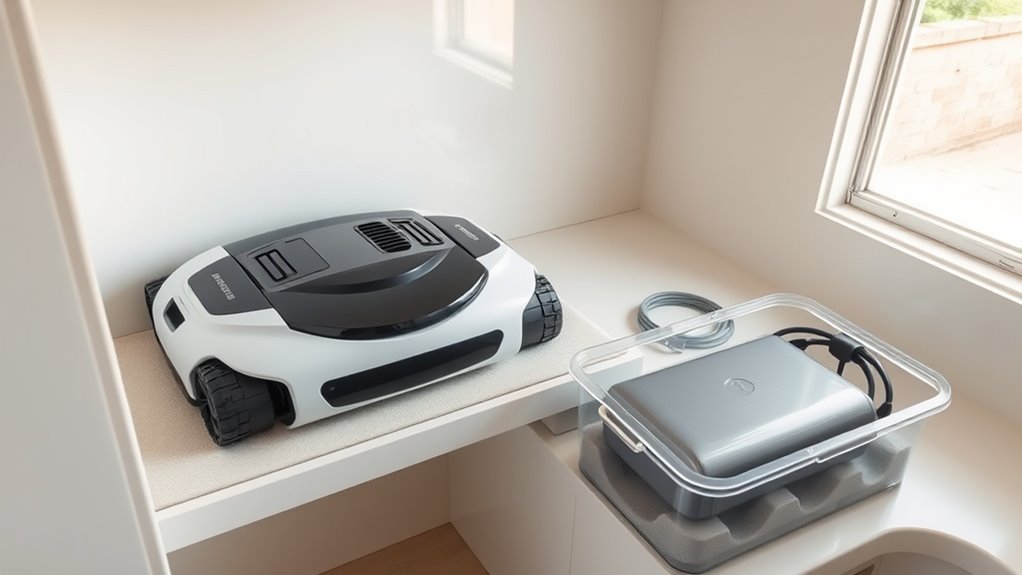
When you’re not using your robotic pool cleaner, proper storage is crucial to maintain its battery’s health and ensure it’s ready for the next swim. Store the cleaner in a cool, dry place away from direct sunlight and extreme temperatures. If the battery isn’t going to be used for a while, charge it to about 50-70%, then disconnect it to prevent overcharging. Never leave a depleted or fully charged battery stored for long periods, as this can reduce its lifespan. When disposing of old or damaged batteries, follow local regulations for battery disposal and recycling. Recycling helps prevent environmental harm and conserves resources. Proper storage and responsible disposal are key to extending your cleaner’s battery life and supporting eco-friendly practices.
Recognizing Signs of Battery Wear and When to Replace
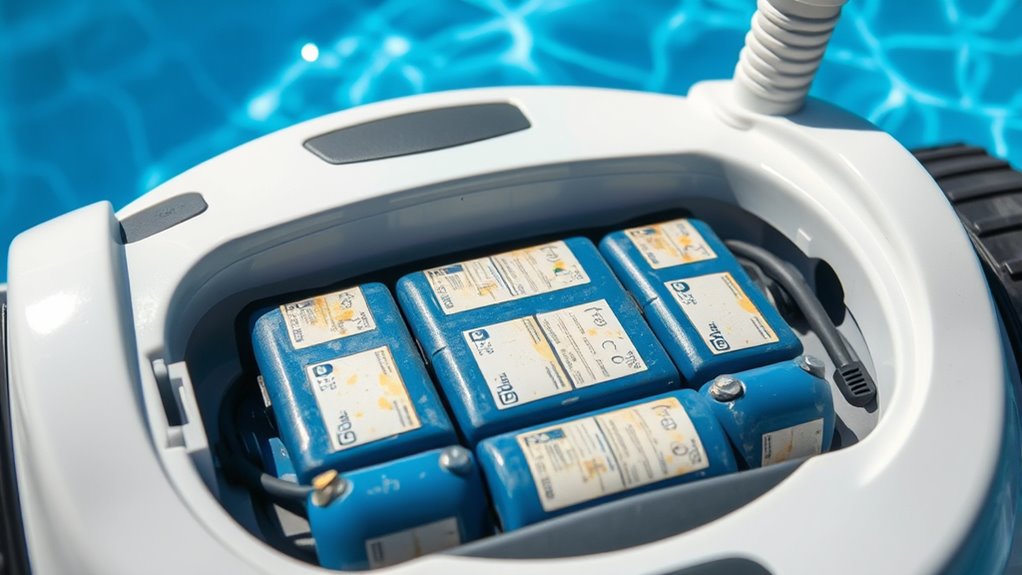
Over time, your robotic pool cleaner’s battery may start showing signs of wear that affect its performance. As the battery approaches the end of its lifespan, you’ll notice shorter cleaning sessions and longer recharge times. Pay attention to the number of charging cycles; after about 300-500 cycles, the battery may no longer hold ideal charge. Signs of wear include reduced runtime, inconsistent power, and difficulty reaching full charge. Keep an eye out for:
Watch for shorter cleaning times and longer charges as your robotic pool cleaner’s battery ages.
- Shorter cleaning durations
- Longer charging times
- Sudden power drops
- Inability to hold a full charge
- Physical swelling or damage
Replacing the battery at the right time ensures your cleaner operates efficiently, preventing damage to the device and maintaining ideal cleaning performance. Recognizing these signs helps you know when it’s time for a fresh battery.
Frequently Asked Questions
How Long Does a Typical Battery Last Before Needing Replacement?
Your battery lifespan for a cordless robotic pool cleaner usually ranges from 2 to 4 years, depending on usage and maintenance. When you notice reduced runtime or performance, it’s time for battery replacement. Proper care, like avoiding overcharging and keeping it clean, can extend the battery’s life. Regularly monitoring your battery helps you know when it’s nearing the end of its useful life, ensuring smooth operation.
Can I Use Third-Party Chargers With My Robotic Pool Cleaner?
Did you know that using the wrong charger can reduce your battery’s lifespan by up to 50%? When it comes to charger compatibility, it’s best to stick with the manufacturer’s charger to guarantee battery safety. Third-party chargers might seem convenient, but they often lack proper voltage regulation, risking damage. Always choose a compatible, high-quality charger to protect your investment and keep your robotic pool cleaner running smoothly.
Is There a Recommended Cleaning Schedule for the Battery Contacts?
You should follow a regular cleaning schedule for your battery contact maintenance to guarantee ideal performance. It’s best to inspect and clean the contacts every few uses, using a soft brush or cloth to remove any dirt, debris, or corrosion. This routine helps prevent connectivity issues and extends your cleaner’s battery life. Staying consistent with your cleaning schedule keeps your robotic pool cleaner working efficiently and prolongs its overall lifespan.
What Are the Environmental Impacts of Disposing of Old Batteries?
Disposing of old batteries can harm the environment because they contain hazardous waste, like heavy metals and chemicals. You should prioritize battery recycling to prevent pollution and reduce the risk of contaminating soil and water. Proper disposal guarantees these hazardous materials are safely managed, protecting ecosystems and public health. Always follow local guidelines for battery recycling, and avoid throwing batteries in regular trash to minimize environmental impacts.
How Can I Tell if My Battery Is Underperforming During Use?
Think of your battery like an aging hero losing strength. You’ll notice battery performance declines, like shorter cleaning cycles or longer recharge times. Look for indicator signs such as inconsistent power or unexpected shutdowns. If these signs appear, it’s a clear signal your battery isn’t performing as it once did. Keeping an eye on these clues helps you catch issues early and extend your device’s lifespan.
Conclusion
So, now that you’re a battery care expert, go ahead and treat your robotic pool cleaner’s battery like royalty—just don’t forget to check it regularly or risk your pool turning into a swamp. Follow these tips, avoid turning your robot into a paperweight, and enjoy crystal-clear water without the drama. After all, a happy battery means a happy pool—and nobody wants to explain to their friends why their robot’s on strike!
